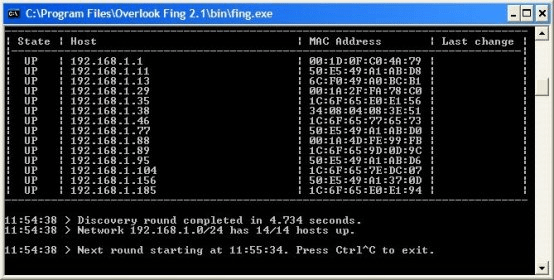
- FING FOR MAC COMMAND LINE HOW TO
- FING FOR MAC COMMAND LINE WINDOWS 8
- FING FOR MAC COMMAND LINE WINDOWS
FING FOR MAC COMMAND LINE HOW TO
How to delete a directory in Linux without prompting? Empty file Using cat/cp/dd utilities with /dev/null.Empty file with “true” command redirection.Empty the contents of the file by redirecting it to null.How do I delete the contents of a file?ĥ Ways to Empty or Delete Large File Contents in Linux General options available with mv include: -i - interactive. To move files, use the mv (man mv) command, which is similar to the cp command, except that mv physically moves the file from one location to another instead of duplicating it like cp does.
FING FOR MAC COMMAND LINE WINDOWS
The directory you changed to is displayed on the command line.Ĭan I delete EFI partition in Windows 10? How do I move files in the terminal? Type cd followed by a space, drag and drop the folder into the window and press Enter. If the folder you want to open in Command Prompt is on your desktop or is already open in File Explorer, you can quickly navigate to that directory. How do I open a folder in Command Prompt? Directories deleted with the rmdir command cannot be restored, nor can directories and their contents deleted with the rm -r command. To remove a directory and all of its contents, including all subdirectories and files, use the rm command with the recursive -r option. You can only delete one file with the Unlink command. You can use the rm command to delete multiple files at once. You can use the rm (remove) or unlink command to remove or unlink a file from the Linux command line. This command moves a file to another directory, changes its name and leaves it in place, or both. The traditional way to rename a file is to use the mv command.
FING FOR MAC COMMAND LINE WINDOWS 8
Open the file with the gnome-open command.Ĭan I download Windows 8 online? How do I change a filename on Linux?.Be very careful with this command because using the rm -r command will not only delete everything in the named directory, but also everything in its subdirectories. To delete a non-empty directory, use the rm command with the -r option for recursive deletion. As an example, suppose you want to copy the /etc directory to a backup folder called /etc_backup. To copy a directory on Linux, you must run the “cp” command with the “-R” option for recursive and specify the source and target directories to copy. do > “$file” empties the file and doesn’t display anything in it (i.e.when reading the file for each line of the given file save the line in a variable file.List of files in a separate file solution To navigate to the root directory, use “cd /”.Ĭan you get Microsoft Teams on Linux? How to undo multiple files on Linux?.To navigate to the previous (or back) directory use “cd -”.To go up one directory level, use “cd.To access your home directory, use “cd” or “cd ~”.For example, if a file is not writable, rm will ask you whether you want to delete that file or not, to avoid this and just run the operation. To force delete a file or directory, you can use the -f option to force a delete without rm prompting you for confirmation. 2019 How to force delete a file in Linux? -delete: Deletes all files in the specified directory name.How to delete a directory in Linux without prompting?.


What command is used to delete a folder?.


 0 kommentar(er)
0 kommentar(er)
